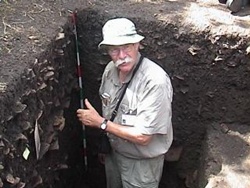 The world’s soils hold more carbon than the atmosphere yet soil conservation and enhancement are often largely overlooked when it comes to climate change adaptation and mitigation plans and projects, according to the UN Convention on Climate Change and Desertification—this even as “extraordinary demands are being placed on agricultural systems to produce food, fiber and energy.”
The world’s soils hold more carbon than the atmosphere yet soil conservation and enhancement are often largely overlooked when it comes to climate change adaptation and mitigation plans and projects, according to the UN Convention on Climate Change and Desertification—this even as “extraordinary demands are being placed on agricultural systems to produce food, fiber and energy.”
The UNCCD is out to change that. At the UN Convention on Climate Change meeting in Poznan it advocated more support for projects involving production and sequestration of biochar, essentially charcoal, as a means not only of sequestering carbon but producing renewable fuels, enhancing soil fertility and agricultural productivity, as well as a means of improving drought and flood resistance and preserving biodiversity.
In order for this to happen, those who manage lands need to be engaged and offered greater access to international agency resources, including carbon credits, markets and other finance mechanisms, “especially in the tropics where sustaining soil organic carbon and soil fertility is most challenging and CO2 emissions due to land use change are highest,” the UNCCD says.
“Researchers are concerned with the negative effects on soil fertility if crop residues are removed for bio-energy production. Pyrolysis with biochar carbon sequestration provides a tool to combine sustainable soil organic carbon management and renewable energy production. While producing renewable energy from biomass, SOC sequestration, agricultural productivity and environmental quality can be sustained and improved if the biomass is transferred to an inactive carbon pool and redistributed to agricultural fields thus making them complementary rather than competing uses.”
Terra Preta de Indio
Humans have known of and used charcoal and the process of pyrolysis to their advantage for ages: so-called “dark earth,” or Terra Preta de Indio, soils hundreds and thousands of years old have been excavated and studied by researchers. It’s the process through which charcoal, activated carbon and methanol and other chemicals from woods are still produced today, as well as that which occurs when we bake, fry and grill foods.
Rather than working them into soils, farmers typically burn plant residues in order to avoid problems associated with their accumulation—higher susceptibility to wildfire, insect attachment and disease, and higher N20 and CH4 (methane) emissions. The worldwide total carbon release from burning is of the order of 4-7 gigatons per year. “This flux is almost as large as the rate of fossil fuel consumption (about 6 Gt per year in 1990),” according to the UNCCD.
Incomplete burning of plant and other organic material–pyrolysis, or its more extreme form, carbonization—to produce both biofuel and biochar, coupled with biochar sequestration, affords a relatively simple, low cost, low tech and extremely effective means of permanently storing carbon while at the same time producing biofuel, enhancing soil fertility, agricultural productivity, improving resistance to erosion and drought, and protecting biodiversity, the UNCCD maintains. It’s a method that can be used both at small scales (cooking stoves) as well as large (biorefineries), and one that offers relative ease of quantifying actual carbon capture and storage, the agency notes.
Numerous benefits and relative advantages would accrue to societies if small- and large-scale biofuel/biofuel projects were to be launched, the agency asserts. Only 2 to 20% of the carbon contained in above ground plant residues and root biomass enters the pool of soil organic carbon by the natural process of humification. The rest is converted to carbon dioxide as a result of oxidation, and what remains is subject to further possible oxidation. In contrast, converting this biomass to biochar captures about 50% of the carbon in an inert form that can considered a “permanent” form of carbon storage.
With soil erosion and desertification a growing concern in many countries, “the fact that many of the drylands soils have been degraded means that they are currently far from saturated with carbon and their potential to sequester carbon may be very high (Farage et al 2003) making the consideration of biochar, as a strategy for enhancing soils carbon sequestration, imperative,” the UNCCD maintains.
Experiments show that adding biochar to soil results in enhanced colonization rates by mycorrhizal fungi, which enhances nutrient uptake and plant growth. A 2006 review of 24 studies of soils where biochar had been added to soils found improved productivity ranging from 20 to 220% in all of them, at application rates of 0.4 to 8 tons carbon per hectare. Researchers studying Amazonian “dark earth” soils found high concentrations of charcoal and significantly more nutrients available to plants than in surrounding soils. Moreover, infertile soils can be transformed into permanently fertile soils despite weathering rates 100 times greater than those found in mid-latitude soils.
Pyrolysis in these soils converts biomass into energy in the form of hydrogen-rich gas and biofuel while producing biochar as a by-product. Avoided emissions of greenhouse gases are between 2 and 5 times greater when biochar is applied to agricultural land than used solely for fossil energy offsets. The potential revenues from carbon trading alone can justify optimizing pyrolysis to produce biochar for application to land, according to the UNCCD.



The coal in the ground seems to be very important for the agricultural productivity and simultaneously also for carbon sequestration.
Consider a source for biomass that is right near the worst desertification, and is contributing enormously to the problem: the cattail infestation in the Lake Chad basin in Africa. Alternatively, it can be readily made into ethanol. Some of it is fit for human consumption. But all of it can be used for biogas and biochar, and its clearance would renew the aquifers whose depletion expands the Sahel. This mass is huge, and needs clearance.